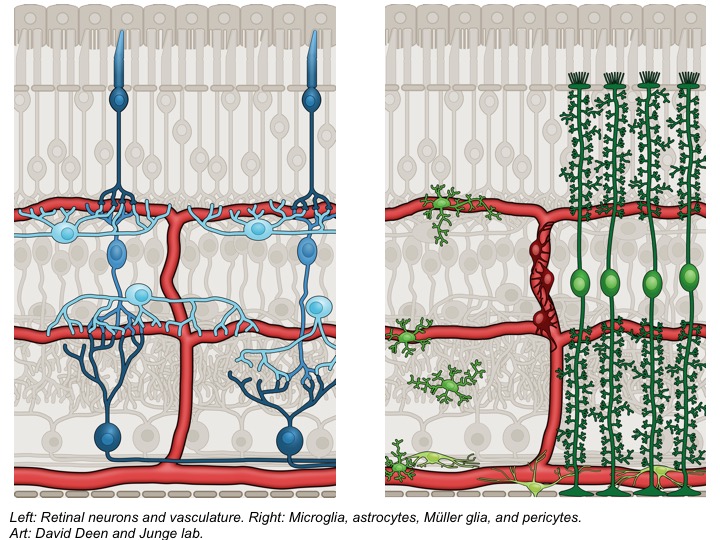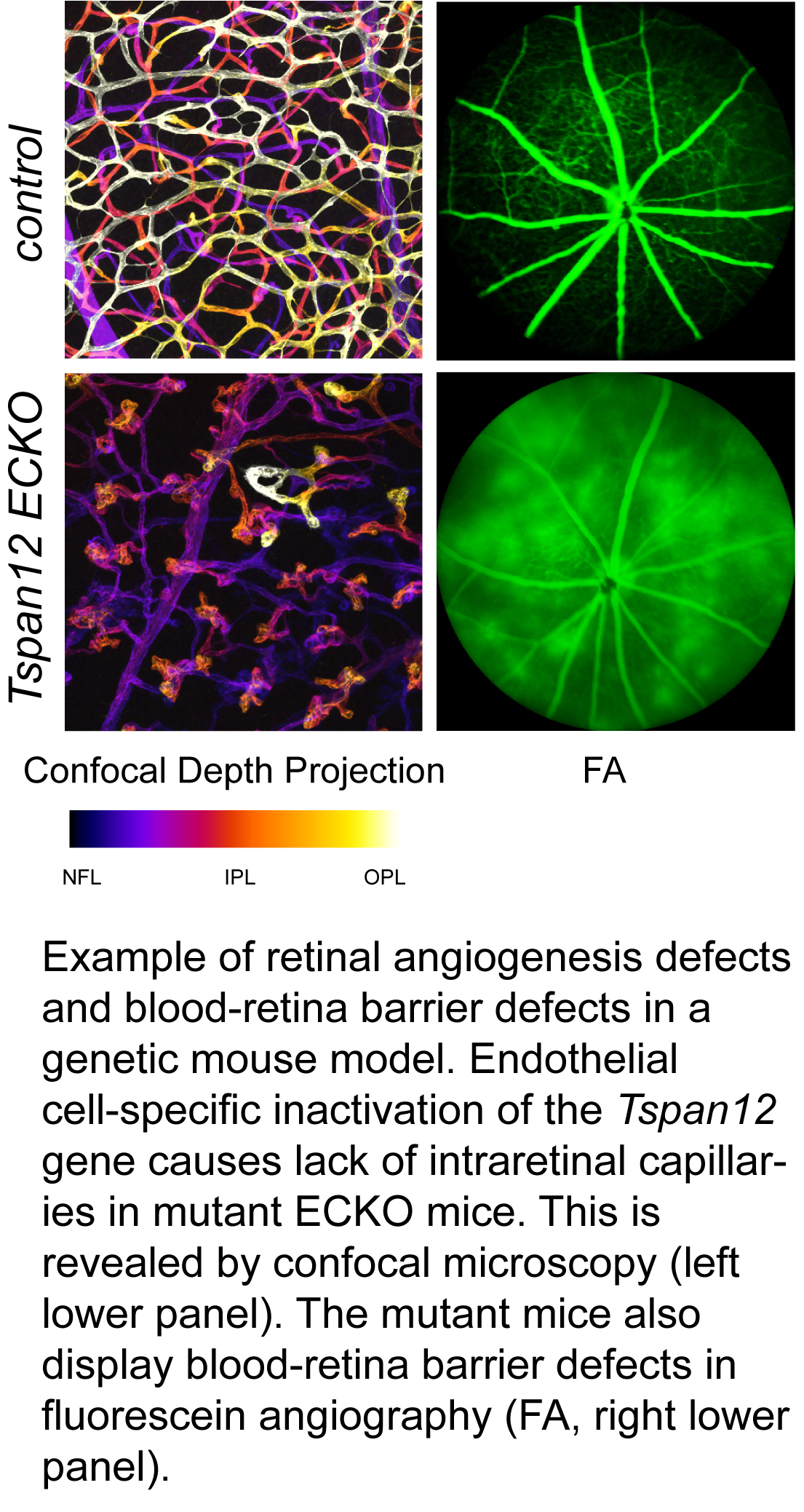Junge Lab
Harald Junge, Ph.D.
Associate Professor
Department of Ophthalmol. and Visual Neurosci.
University of Minnesota
Room 310A LRB, 2001 6th St SE
Minneapolis, MN 55455
email: junge@umn.edu
Research Topics

- Neurovascular interactions
- Blood-retina barrier
- Retinal angiogenesis
- Retinopathies, familial exudative vitreoretinopathy
- Norrin and Wnt signaling
- Classical complement system
Overview
The major goals of my laboratory are to understand neurovascular signaling in the eye and visual system using the mouse as a model system. Areas of focus are regulation of the blood-retina barrier and retinal angiogenesis by neural signals, how the pathways under study function at the molecular level, and the application of novel transgenic mouse models to study ocular disease. We use integrated approaches including mouse genetics, cell-based assays, molecular manipulations (e.g., CRISPR/Cas9), RNA-Seq, and proteomics to understand processes at cellular, developmental, and disease levels.
Significance
Neurovascular communication is critical for the function of the retina and brain. For instance, neural signals induce and maintain the blood-CNS barriers (including blood-brain and inner blood-retina barrier). These barriers limit non-selective diffusion of solutes from the blood into the CNS. Instead, they mediate highly selective transport of nutrients, proteins and hormones into the CNS, and of waste products out of the CNS. Furthermore, blood-CNS barriers limit the extravasation of immune cells, contributing to the relative immune privilege of the CNS. These barriers provide a significant obstacle for pharmacotherapy of ocular and neurological diseases. Blood-CNS barrier dysfunction is implicated in prevalent retinal diseases, such as diabetic retinopathy, and neurological diseases, for example stroke, neurodegenerative diseases, and epilepsy. Therefore, it is important to understand the mechanistic basis of barrier maintenance and how the barriers can be modulated by interfering with neurovascular signaling.
The appropriate formation of CNS blood vessels by outgrowth from pre-existing vessels (angiogenesis) occurs in development and is essential for retina and brain function. Once an appropriate vasculature has been formed, blood vessels become quiescent and cease to form additional ramifications of the CNS vascular tree. However, in pathological conditions, blood vessels may become reactivated and form super-numerous and aberrant neo-vessels that damage the surrounding tissue. In ocular diseases, including proliferative diabetic retinopathy and type III choroidal neovascularization, pathological growth of neo-vessels leads to impaired vision or blindness. Anti-angiogenec therapies that target the VEGF proangiogenic signal are not always effective or cease to be effective during treatment of proliferative retinopathies. This may be in part because CNS angiogenesis is governed by specialized neural signals besides VEGF, including Wnt and Norrin signals. Therefore, it is important to understand CNS-specific mechanisms of angiogenesis and quiescence.

Progress

A major focus of our studies on neurovascular signaling is the Norrin/Frizzled4 pathway, which is essential for CNS angiogenesis and blood-CNS barrier function. This pathway is best understood in the retina, although it also has functions in other CNS regions. The ligand Norrin is released from the neuroretina (including Müller glia) and activates signaling in vascular endothelial cells via a receptor complex containing Frizzled4. Frizzled4 engages other membrane proteins to form receptor complexes in a combinatorial manner. This enables Frizzled4 to respond selectively to distinct ligands. We reported the first of such receptor complex co-factors, the tetraspanin family member Tspan12, and showed that Tspan12 increases the ligand selectivity of Frizzled4 towards Norrin, and revealed why mutations in Tspan12 cause familial exudative vitreoretinopathy (Lai et al., 2017).
Our studies on Norrin/Frizzled4 signaling provided novel mechanistic insights into neurovascular signaling pathways. For instance, we discovered a novel role for Norrin-induced endocytosis of Frizzled4 in CNS vascular biology (Zhang et al., 2017). This study highlights our application of impactful mouse genetic approaches, involving the generation of novel mouse alleles; for this study we created a conditional allele that inducibly blocks trafficking through the endolysosomal pathway in vivo.
We created a mouse model that is useful to understand the role of blood-CNS barrier defects in retinal disease, and in a wider sense, neurological disease. Inducible deletion of the Tspan12 gene in vascular endothelial cells allowed us to establish a disease model characterized by blood-retina barrier defects in an otherwise intact vasculature. We identified the involvement of the classical complement system downstream of blood-retina barrier breakdown and characterized long-term pathological consequences (Zhang and Lai et al., 2018).
We explored how loss of Very low-density lipoprotein receptor (VLDLR) leads to severe pathological retinal neovascularization. Vldlr-/-mice are a model for type III choroidal neovascularization. In a detailed phenotypic analysis, we showed that neovascularization occurs in the context of preceding developmental defects, including altered intraretinal capillary development and neurite mistargeting. Intriguingly, neovascular lesions develop in close association with mistargeted neurites, however, mistargeted neurites (at least those of horizontal cell neurons) are not necessary for the process of neovascularization (Johnson et al., 2015).
Outlook and research platform
Current projects focus on the role of the classical complement system in blood-retina barrier dysfunction, regulation of the blood-retina barrier under stress, testing novel therapeutic approaches in mouse models, and mechanistic analyses of neurovascular signaling pathways.

Selected Publications
Endothelial Cell-Specific Inactivation of TSPAN12 (Tetraspanin 12) Reveals Pathological Consequences of Barrier Defects in an Otherwise Intact Vasculature. Zhang C, Lai MB, Pedler MG, Johnson V, Adams RH, Petrash JM, Chen Z, Junge HJ. Arterioscler Thromb Vasc Biol. 2018 Nov;38(11):2691-2705.
Ligand-Selective Wnt Receptor Complexes in CNS Blood Vessels: RECK and GPR124 Plugged In. Junge HJ. Neuron. 2017 Aug 30;95(5):983-985.
TSPAN12 is a Norrin Co-Receptor that Amplifies Frizzled4 Ligand Selectivity and Signaling.? Lai MB, Zhang C, Shi J, Johnson V, Khandan L, McVey J, Klymkowsky MW, Chen Z, Junge HJ. Cell Rep. 2017 Jun 27;19(13):2809-2822.
Norrin-induced Frizzled4 endocytosis and endo-lysosomal trafficking control retinal angiogenesis and barrier function.? Zhang C, Lai MB, Khandan L, Lee LA, Chen Z, Junge HJ. Nat Commun. 2017 Jul 4;8:16050. doi: 10.1038/ncomms16050.
Neurite Mistargeting and Inverse Order of Intraretinal Vascular Plexus Formation Precede Subretinal Vascularization in Vldlr Mutant Mice. Johnson V, Xiang M, Chen Z, Junge HJ.? PLoS One. 2015 Jul 15;10(7):e0132013.
TSPAN12 regulates retinal vascular development by promoting Norrin- but not Wnt-induced FZD4/beta-catenin signaling. ?Junge, HJ, Yang, S, Burton, JB, Paes, K, Shu, X, French, DM, Costa, M, Rice, DS, and Ye, W. Cell, 139(2):299-311. 2009.
Calmodulin and Munc13 form a Ca2+ sensor/effector complex that controls short-term synaptic plasticity.? Junge, HJ, Rhee, J, Jahn, O, Varoqueaux, F, Spiess, J, Waxham, MN, Rosenmund, C, and Brose, N. Cell, 118(3):389-401. 2004.
See complete publication list here: